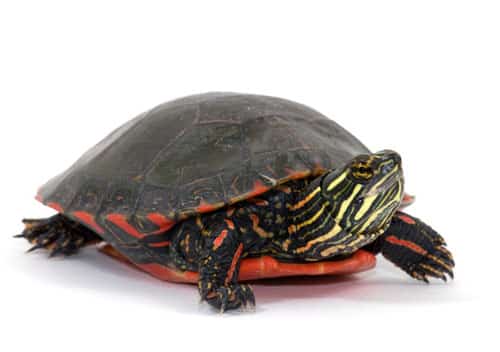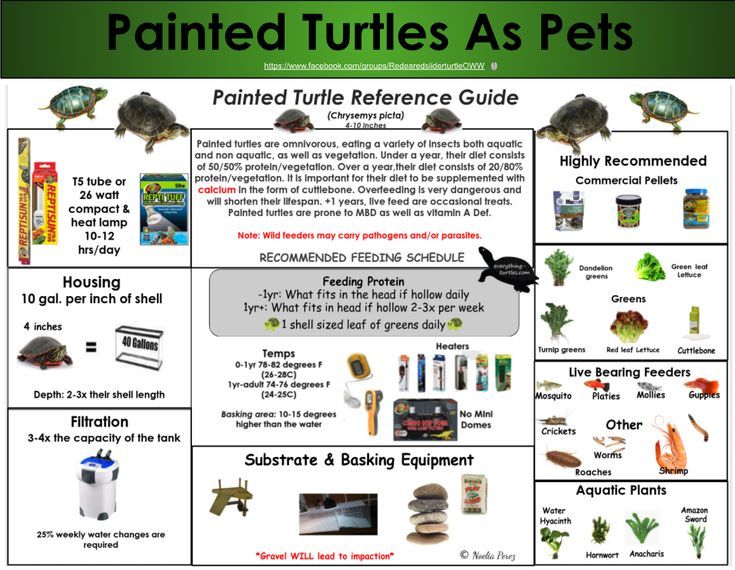To care for a painted turtle, provide a spacious tank with clean water, UVB lighting, and a basking area. Maintain water temperature between 75-80°F and offer a varied diet of aquatic plants and protein sources.
Painted turtles need a balance of land and water areas in their habitat to thrive. Adequate space, proper diet, and environmental conditions are essential for the health and well-being of your painted turtle. By following these care guidelines, you can ensure your painted turtle lives a happy and healthy life in captivity.
:strip_icc()/GettyImages-561461945-574a20573df78ccee1de80bd.jpg)
Credit: www.thesprucepets.com
Habitat Setup
Painted turtles are delightful creatures that require a well-thought-out habitat for them to thrive. Proper habitat setup is crucial for their health and well-being. Let’s delve into the essential aspects of creating an ideal environment for your painted turtle.
Aquarium Size
An appropriate aquarium size for a painted turtle is at least 20 gallons for a single turtle. Ensure the tank has enough space for swimming and basking.
Water And Land Areas
- Provide a 75% water area and 25% land area in the aquarium.
- Include a basking area with a heat lamp and rocks or logs for climbing.
Temperature And Lighting
- Maintain water temperature at 75-80°F and basking spot at 85-90°F.
- Use UVB lighting to help with calcium absorption and overall health.
Filtration And Cleaning
Install a good quality filter to keep the water clean and change 25% of the water weekly. Regularly clean the tank and remove any uneaten food to maintain a healthy environment for your painted turtle.

Credit: www.youtube.com
Feeding And Nutrition
To properly care for a painted turtle, it is important to provide a balanced diet that includes both protein and vegetables. Commercial turtle food, earthworms, and leafy greens are all excellent options. It is also important to offer calcium supplements and provide a clean, spacious environment for the turtle to thrive.
Painted turtles are omnivores, which means they require a varied diet to stay healthy. Feeding your painted turtle the right food in the correct amount is crucial to their well-being. In this section, we’ll discuss the dietary requirements, feeding schedule, and supplements necessary for your painted turtle’s health.Dietary Requirements
Painted turtles require a balanced diet that includes both animal and plant matter. They need protein for growth and development, and calcium for the formation and maintenance of their shell. Some good sources of animal protein include earthworms, crickets, mealworms, and feeder fish. Offer these foods in moderation, as excessive amounts can lead to obesity and other health issues. In addition to animal protein, your painted turtle needs a variety of plant matter. Offer dark leafy greens like kale and collard greens, as well as vegetables like carrots and squash. You can also offer fruits like berries and melon as an occasional treat.Feeding Schedule
Feed your painted turtle once a day, either in the morning or evening. Younger turtles may require more frequent feedings, up to twice a day. Offer only as much food as your turtle can eat in about 15 minutes. Remove any uneaten food to prevent it from spoiling the water.Supplements
In addition to a balanced diet, your painted turtle may require supplements to stay healthy. Calcium and vitamin D3 are essential for shell health, so you may need to provide a calcium supplement if your turtle isn’t getting enough from their diet. You can also offer a multivitamin supplement to ensure they are getting all the necessary nutrients. Remember, a healthy diet is essential for your painted turtle’s well-being. By providing a balanced diet, feeding on a schedule, and offering necessary supplements, you can ensure your turtle lives a long and healthy life.Health And Hygiene
When it comes to caring for a painted turtle, ensuring their health and hygiene is crucial for their well-being. Proper maintenance and attentive care can help prevent common health issues and ensure your turtle lives a long and healthy life. In this section, we’ll discuss common health issues, signs of illness, and the importance of veterinary care for painted turtles.
Common Health Issues
Painted turtles are susceptible to a few common health issues that owners should be aware of. These include:
- Shell rot
- Respiratory infections
- Vitamin deficiencies
Signs Of Illness
It’s essential to be vigilant for any signs of illness in your painted turtle. Some common indicators of health problems include:
- Abnormal behavior
- Loss of appetite
- Cloudy eyes
- Shell abnormalities
Veterinary Care
If you notice any signs of illness or are concerned about your painted turtle’s health, it’s crucial to seek veterinary care promptly. A reptile veterinarian can provide a thorough examination, diagnostic tests, and treatment options to address any health issues and ensure your turtle’s well-being.
Handling And Interaction
Painted turtles are fascinating pets to have, but it’s essential to handle and interact with them properly to ensure their well-being. This section will cover safe handling techniques and enrichment activities to keep your painted turtle happy and healthy.
Safe Handling Techniques
When handling your painted turtle, it’s crucial to follow these safe techniques to prevent stress or injury to the turtle:
- Wash your hands: Before and after handling your turtle, always wash your hands with mild soap to prevent the spread of bacteria.
- Support the turtle: When picking up your turtle, support its body with both hands to avoid putting pressure on its legs or shell.
- Handle gently: Avoid sudden movements and handle the turtle gently to prevent stress or injury.
- Avoid excessive handling: Limit the amount of time you handle your turtle to reduce stress and allow it to rest.
Enrichment Activities
Enrichment activities are essential for keeping painted turtles mentally and physically stimulated. Here are some enrichment activities to consider:
- Provide a varied diet: Offer a diverse range of foods, including insects, aquatic plants, and commercial turtle pellets, to keep your turtle engaged during feeding time.
- Introduce obstacles: Create a stimulating environment by adding obstacles such as floating platforms or tunnels for your turtle to explore and interact with.
- Swimming space: Ensure your turtle has ample space to swim and explore, as this is essential for their physical and mental well-being.
- Hideouts: Place rocks, plants, or other natural hideouts in the enclosure to provide your turtle with places to explore and retreat to when it needs privacy.
Reproduction
Reproduction is an essential aspect of painted turtle care, as it ensures the continuation of their species. Understanding the mating behavior, nesting, and egg incubation process is crucial for turtle enthusiasts and those looking to provide the best care for these fascinating creatures.
Mating Behavior
Painted turtles typically mate in the spring or early summer, with courtship rituals often taking place in the water. Male turtles will swim around the female, using their long claws to gently stroke her face and neck. This behavior stimulates the female and indicates the male’s interest in mating. Once the female is receptive, mating occurs underwater, where the male fertilizes the eggs inside the female’s body.
Nesting And Egg Incubation
After mating, the female painted turtle will search for a suitable nesting site, often choosing sandy or gravelly areas with easy access to sunlight. She will use her hind legs to dig a hole, where she will lay a clutch of eggs, typically ranging from 5 to 20 eggs, depending on the turtle’s age and size. Once the eggs are laid, the female covers the nest with soil and compact it to protect the eggs from predators.
The incubation period for painted turtle eggs is approximately 72 to 80 days. During this time, the eggs absorb moisture from the surrounding environment, and the temperature plays a crucial role in determining the hatchling’s gender. Warmer temperatures tend to produce more females, while cooler temperatures result in more males.

Credit: reptilesmagazine.com
Legal Considerations
When it comes to caring for a painted turtle, it’s important to be aware of the legal considerations surrounding their ownership. Understanding the regulations and protected species status is crucial to ensuring the well-being of these fascinating creatures.
Regulations On Ownership
Before bringing a painted turtle into your home, it’s essential to familiarize yourself with the regulations on ownership. Different states and countries may have specific laws and requirements regarding the keeping of painted turtles as pets. Some regions may necessitate obtaining a permit or license to own a painted turtle. It’s imperative to research and comply with the local regulations to ensure legal and responsible ownership.
Protected Species Status
In addition to ownership regulations, it’s vital to be aware of the protected species status of painted turtles. These turtles are often considered protected wildlife due to their ecological significance and potential vulnerability. As such, it’s crucial to respect and adhere to any laws or designations that classify painted turtles as protected species. This status may come with specific guidelines for their care and conservation, emphasizing the need for responsible ownership and ethical treatment of these animals.
Conclusion
In caring for a painted turtle, remember to provide proper habitat, diet, and care. Regular veterinary check-ups are essential. By following these tips, you can ensure your painted turtle leads a healthy and happy life. Stay informed, stay attentive, and enjoy your time with your colorful reptilian companion.






Leave a Reply